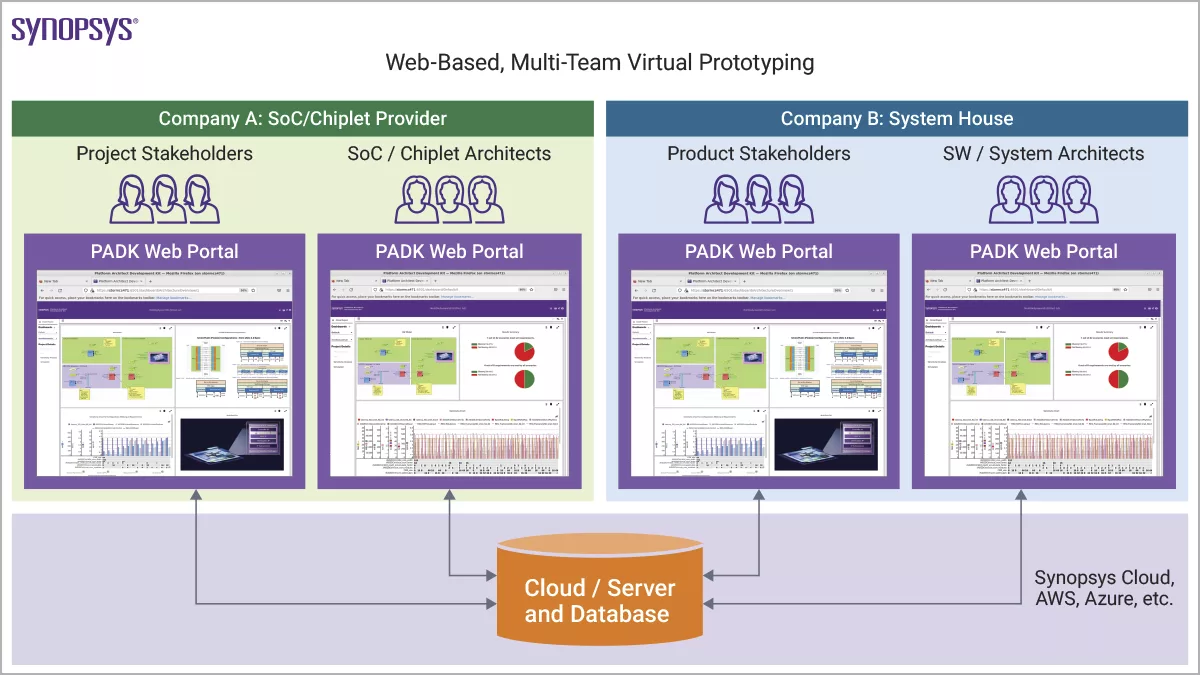Systems-on-chip (SoCs) and chiplet-based semiconductors continue to grow in complexity. With multi-die architectures, AI accelerators, and increasing memory bandwidth becoming the norm, it’s more important than ever to address performance and power early in the design cycle.
Traditional architecture exploration approaches like spreadsheets, RTL simulation, and ad hoc communication are slow and manually intensive, often resulting in fragmented workflows and delayed feedback. Simply put, these antiquated methods can no longer support today’s pace of silicon innovation.
To streamline early-stage architecture exploration, we recently introduced the Synopsys Platform Architect Development Kit (PADK), a web-based collaboration framework that extends the proven capabilities of Platform Architect into a more accessible, interactive, and role-based environment for architecture design teams.
Web-based, role-focused virtual prototyping
Platform Architect is a SystemC, TLM-based virtual prototyping environment for pre-RTL architecture exploration. By simulating the performance and power characteristics of SoC and chiplet workloads, Platform Architect has become a vital tool for design teams developing silicon for AI, automotive, and high-performance computing (HPC) applications.
A lightweight, web-based extension of Platform Architect, the new PADK further improves architecture exploration through structured, role-focused collaboration.
PADK addresses three persistent challenges in pre-RTL system design:
1. Siloed communication between architects, stakeholders, and customers.
2. The manual burden of converting simulation outputs into reports or presentations.
3. The difficulty of protecting confidential IP or workload data during customer-facing validation.
With PADK, users access a secure, web-based interface that facilitates real-time collaboration without requiring deep simulation expertise. Customizable dashboards present important performance metrics (e.g., latency, power, and area), while role-based access control guarantees users view only the data relevant to their responsibilities.
Uploaded documentation — including AI graphs and trace files — is encrypted, allowing customers to evaluate performance without exposing sensitive data. And because PADK supports in-browser simulation, users can easily tweak parameters or explore alternative configurations without waiting for modeling teams.
By unlocking frictionless data sharing, fast simulation and iteration, and cross-team alignment, PADK delivers a more agile and collaborative approach to SoC and chiplet architecture exploration and performance analysis.

The PADK workflow
The standard PADK workflow is as follows:
1. PADK creation and packaging. A PADK creator (typically an architect or enablement team member) uses Platform Architect to assemble a virtual prototype, configure workloads, and define KPIs. The creator packages the PADK — including libraries, scripts, trace files, and config parameters — into a zip archive.
2. Cloud or on-prem upload. The PADK package is then uploaded to a cloud or on-prem server and becomes accessible through the PADK portal.
3. Web portal access and simulation. Users log in via browser, view shared dashboards, filter/sort data, and run new simulations (changing bandwidth, CSM size, etc.).
4. Result management and sharing. Simulation results stay private until shared and can be added to dashboards with a few clicks.
Improving collaboration, speed, and flexibility
Though applicable across industries, PADK is particularly valuable in fast-evolving sectors like automotive, AI acceleration, and HPC. Ultimately, it helps teams make better architectural choices, faster.
PADK reshapes how architecture teams explore and align around early design decisions by removing long feedback cycles and unlocking more agile interaction.
· Instead of waiting days or weeks for simulation experts to process new workloads, users can run their own experiments directly through the browser and get immediate insight into performance impacts.
· PADK’s cloud-ready architecture supports distributed teams without the complexity of local tool installations or IT setup.
· Role-based access control ensures each user — whether an architect, project manager, or external partner — only engages with the data appropriate to their role. This includes secure collaboration, data encryption, and selective sharing across company boundaries.

